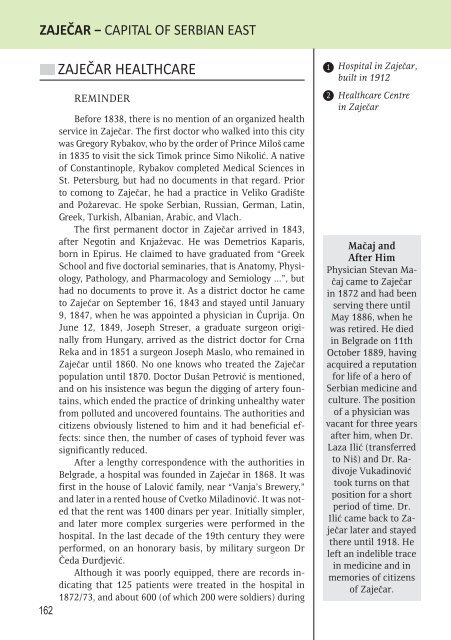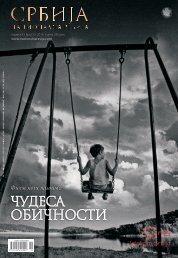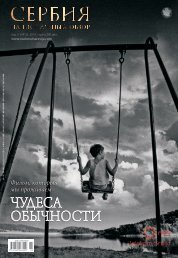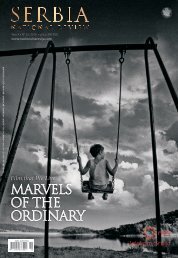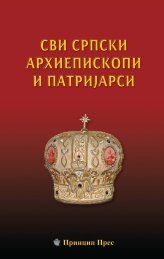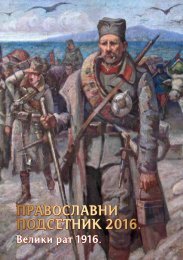Zajecar - engleski - niska rezolucija
Create successful ePaper yourself
Turn your PDF publications into a flip-book with our unique Google optimized e-Paper software.
ZAJEČAR − CAPITAL OF SERBIAN EAST<br />
162<br />
ZAJEČAR HEALTHCARE<br />
REMINDER<br />
Before 1838, there is no mention of an organized health<br />
service in Zaječar. The first doctor who walked into this city<br />
was Gregory Rybakov, who by the order of Prince Miloš came<br />
in 1835 to visit the sick Timok prince Simo Nikolić. A native<br />
of Constantinople, Rybakov completed Medical Sciences in<br />
St. Petersburg, but had no documents in that regard. Prior<br />
to comong to Zaječar, he had a practice in Veliko Gradište<br />
and Požarevac. He spoke Serbian, Russian, German, Latin,<br />
Greek, Turkish, Albanian, Arabic, and Vlach.<br />
The first permanent doctor in Zaječar arrived in 1843,<br />
after Negotin and Knjaževac. He was Demetrios Kaparis,<br />
born in Epirus. He claimed to have graduated from “Greek<br />
School and five doctorial seminaries, that is Anatomy, Physiology,<br />
Pathology, and Pharmacology and Semiology ...”, but<br />
had no documents to prove it. As a district doctor he came<br />
to Zaječar on September 16, 1843 and stayed until January<br />
9, 1847, when he was appointed a physician in Ćuprija. On<br />
June 12, 1849, Joseph Streser, a graduate surgeon originally<br />
from Hungary, arrived as the district doctor for Crna<br />
Reka and in 1851 a surgeon Joseph Maslo, who remained in<br />
Zaječar until 1860. No one knows who treated the Zaječar<br />
population until 1870. Doctor Dušan Petrović is mentioned,<br />
and on his insistence was begun the digging of artery fountains,<br />
which ended the practice of drinking unhealthy water<br />
from polluted and uncovered fountains. The authorities and<br />
citizens obviously listened to him and it had beneficial effects:<br />
since then, the number of cases of typhoid fever was<br />
significantly reduced.<br />
After a lengthy correspondence with the authorities in<br />
Belgrade, a hospital was founded in Zaječar in 1868. It was<br />
first in the house of Lalović family, near “Vanja’s Brewery,”<br />
and later in a rented house of Cvetko Miladinović. It was noted<br />
that the rent was 1400 dinars per year. Initially simpler,<br />
and later more complex surgeries were performed in the<br />
hospital. In the last decade of the 19th century they were<br />
performed, on an honorary basis, by military surgeon Dr<br />
Čeda Đurđjević.<br />
Although it was poorly equipped, there are records indicating<br />
that 125 patients were treated in the hospital in<br />
1872/73, and about 600 (of which 200 were soldiers) during<br />
1<br />
2<br />
Hospital in Zaječar,<br />
built in 1912<br />
Healthcare Centre<br />
in Zaječar<br />
Ma čaj and<br />
After Him<br />
Physician Ste van Mačaj<br />
came to Za je čar<br />
in 1872 and had been<br />
serving there until<br />
May 1886, when he<br />
was retired. He died<br />
in Belgrade on 11th<br />
October 1889, having<br />
acquired a reputation<br />
for life of a hero of<br />
Serbian medicine and<br />
culture. The position<br />
of a physician was<br />
vacant for three years<br />
after him, when Dr.<br />
La za Ilić (transferred<br />
to Niš) and Dr. Radi<br />
vo je Vu ka di no vić<br />
took turns on that<br />
position for a short<br />
period of time. Dr.<br />
Ilić came back to Zaje<br />
čar later and stayed<br />
there until 1918. He<br />
left an indelible trace<br />
in medicine and in<br />
memories of citizens<br />
of Zaječar.


